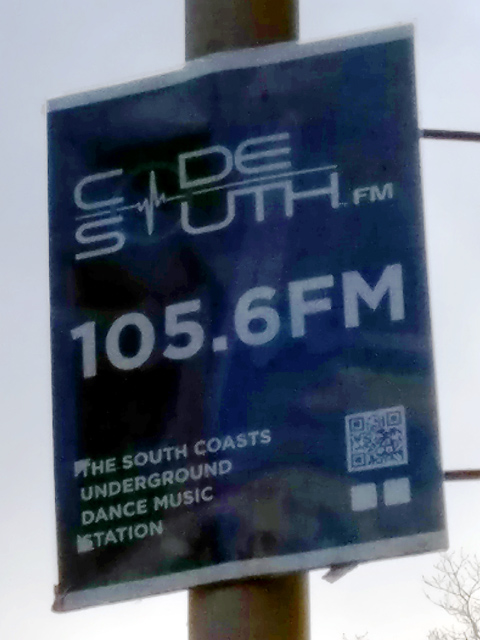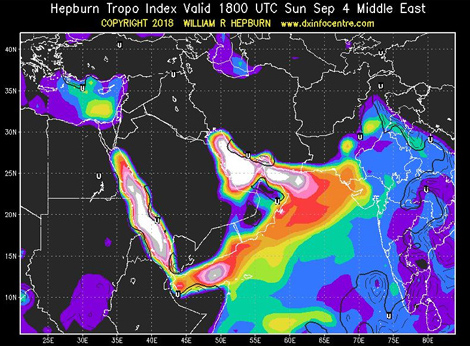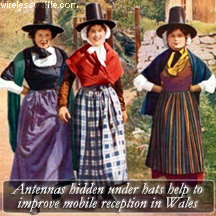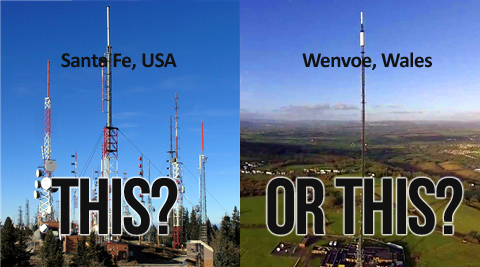 Back in 2008, Wireless Waffle discussed the fact that the licensing of new community radio stations by Ofcom had forced many pirate radio stations to change frequency and in some cases to move to using two (or more) frequencies simultaneously in order to provide wide area coverage without treading on the toes of officially licensed stations.
Back in 2008, Wireless Waffle discussed the fact that the licensing of new community radio stations by Ofcom had forced many pirate radio stations to change frequency and in some cases to move to using two (or more) frequencies simultaneously in order to provide wide area coverage without treading on the toes of officially licensed stations. As the number of community stations continues to grow, the problem of finding a 'clear' frequency for the pirates to operate on becomes increasingly difficult. Indeed, one might even go so far as to suggest that part of the reason for Ofcom's relatively newly found interest in licensing community radio stations is to purposefully force pirates off the airwaves, which would, of course, be in perfect alignment with their objectives as the regulator of the radio spectrum.
For many years Ofcom claimed that there were no FM frequencies available for new radio stations as the band was full, but over the past 10 years or so, they have licensed dozens of community stations all over the country. Being lower power and covering a smaller area they have managed to squeeze a number of stations into a band which had been previously claimed to have no space in it. What is interesting is how similar the frequencies chosen by Ofcom for the community stations are to those that were previously employed by the pirates themselves, suggesting that the frequencies that the pirates were using were well chosen so as to try and avoid causing interference to legitimate stations.
Take, for example, the handful of radio pirates operating in Brighton on the south coast of the UK. The table below shows some of the frequencies used by pirates in the area, and the frequencies used by the four community stations now broadcasting to the city. You will note that there is a large degree of commonality.
| Pirate Station | Frequency | Community Station | Frequency |
|---|---|---|---|
| InFront FM Haven976 | 97.9 97.6 | Gaydio | 97.8 |
| Radio 4A | 101.4 | 1BTN | 101.4 |
| CodeSouth FM | 105.6 | Platform B | 105.5 |
| - | - | Radio Reverb | 97.2 |
 One station, CodeSouth, has changed frequency four times since it first went on air in 2012. Initialy on 108.0, it moved to 88.8 in 2013, then to 98.5 (the frequency previously used by another Brighton pirate 'FIP') from 2014 to 2015, then to 105.6 until late 2018 and is currently on 88.2 MHz. Incidentally, the choice of 88.2 MHz may not be the best, as it is the frequency used by a low-power relay of BBC Radio 2 in nearby Bexhill. Though the relay does not put a strong signal into Brighton and thus the frequency may appear empty, the same may not be true of CodeSouth's big signal heading in the opposite direction (88.0 may have been a better choice). Of course there are a decreasing number of frequencies available and any choice is likely to cause potential interference to someone.
One station, CodeSouth, has changed frequency four times since it first went on air in 2012. Initialy on 108.0, it moved to 88.8 in 2013, then to 98.5 (the frequency previously used by another Brighton pirate 'FIP') from 2014 to 2015, then to 105.6 until late 2018 and is currently on 88.2 MHz. Incidentally, the choice of 88.2 MHz may not be the best, as it is the frequency used by a low-power relay of BBC Radio 2 in nearby Bexhill. Though the relay does not put a strong signal into Brighton and thus the frequency may appear empty, the same may not be true of CodeSouth's big signal heading in the opposite direction (88.0 may have been a better choice). Of course there are a decreasing number of frequencies available and any choice is likely to cause potential interference to someone. The other pirate stations have not been heard of for some time. It seems at least partially feasible that some of the presenters have found their way onto one of the new community stations and as such there is no longer a need for them to fly the jolly radio roger. In this respect, it could be argued that Ofcom's community radio policy has had a double whammy effect and both taken away the frequencies from the pirates, and taken away the needs of the DJ's to use pirate stations as an outlet for their music.
 Despite all the above, the simplicity of Internet streaming (which many of the pirates also do) and the opportunity of space on local DAB multiplexes, the UK's licensing laws must still be failing some part of the musical community, otherwise there would no longer be a need for the pirates. The whole situation sounds hugely reminiscent of the very early days of the pirates, when the BBC launched Radio 1 to try and take away the need for the offshore stations playing 'pop' music, yet the pirates persevered. What will it take to finally find a way to end unlicensed broadcasting, and give everyone who wishes to have a radio show the audience they seek?
Despite all the above, the simplicity of Internet streaming (which many of the pirates also do) and the opportunity of space on local DAB multiplexes, the UK's licensing laws must still be failing some part of the musical community, otherwise there would no longer be a need for the pirates. The whole situation sounds hugely reminiscent of the very early days of the pirates, when the BBC launched Radio 1 to try and take away the need for the offshore stations playing 'pop' music, yet the pirates persevered. What will it take to finally find a way to end unlicensed broadcasting, and give everyone who wishes to have a radio show the audience they seek?add comment
( 1184 views )
| permalink
| 



 ( 3 / 91508 )
( 3 / 91508 )




 ( 3 / 91508 )
( 3 / 91508 )
Friday 8 March, 2019, 13:10 - Broadcasting, Licensed, Radio Randomness, Spectrum Management
Posted by Administrator
A while ago Wireless Waffle added an FM DX logbook listing reception of far distant (a.k.a. DX) FM radio stations which have been received in the UK at various times. Reception of such stations has also been discussed before in particular with reference to sporadic-E propagation. Posted by Administrator
FM stations being received over a long distance by sporadic-E tend to be very strong, and can often overwhealm reception of local stations. Those being received through tropospheric ducting are often somewhat weaker.
 It was a surprise, therefore, on a recent drive around London's orbital motorway, the M25, whilst listening to community station Kane FM at a distance of approximately 13 km from the transmitter, that french station France Inter on the same frequency of 103.7 MHz, became stronger. So much so, that the radio in the car decoded the RDS of France Inter and switched between 103.7 and 99.6 MHz where a second transmitter could be received.
It was a surprise, therefore, on a recent drive around London's orbital motorway, the M25, whilst listening to community station Kane FM at a distance of approximately 13 km from the transmitter, that french station France Inter on the same frequency of 103.7 MHz, became stronger. So much so, that the radio in the car decoded the RDS of France Inter and switched between 103.7 and 99.6 MHz where a second transmitter could be received.  The transmitter of France Inter on 103.7 MHz uses a massive power of 400 kW from a site in Lille (approximately 260 km away). It is actually one of the highest powered FM transmitters in the whole of Europe. The France Inter transmitter on 99.6 MHz uses a transmitter power of 50 kW from a site in Caen (approximately 225 km away). If you consider the free space path loss from these sites, and their transmitter power, you can roughly calculate the expected signal strength that each transmitter would produce.
The transmitter of France Inter on 103.7 MHz uses a massive power of 400 kW from a site in Lille (approximately 260 km away). It is actually one of the highest powered FM transmitters in the whole of Europe. The France Inter transmitter on 99.6 MHz uses a transmitter power of 50 kW from a site in Caen (approximately 225 km away). If you consider the free space path loss from these sites, and their transmitter power, you can roughly calculate the expected signal strength that each transmitter would produce.| Radio Station | Frequency | Power | Distance |  Path Loss |  Field Strength |
|---|---|---|---|---|---|
| Kane FM | 103.7 | 25 W | 13 km | 95 dB | 56 dBuV/m |
| France Inter (Lille) | 103.7 | 400 kW | 260 km | 121 dB | 72 dBuV/m |
| France Inter (Caen) | 99.6 | 50 kW | 225 km | 120 dB | 64 dBuV/m |
Assuming free space loss, therefore, the signals from France would be 8 to 16 dB higher than those from the nearby Kane FM transmitter.
However, this is nothing like reality: free space path loss gives a result which would represent the strongest possible signal that could be received. Of course none of the signals would be propagating in this way, as there would be innumerable obstacles along the way that would deviate wildly from 'free space' and the signals would come nowhere near these values, especially those that have travelled 200 km or more from France. Note that various studies have indicated that for reception in a car, a signal strength around 40 dBuV/m is needed suggesting that the additional path loss caused by propagation effects would have been in the order of 16 to 32 dB, which seems reasonable.
FM receivers have an effect called the 'capture ratio'. In general, if two signals are on the same frequency, and one is more than around 3 dB stronger than the other, then the strongest signal will win-out and the weaker one will disappear. So at least it is clear that the signal from France Inter on 103.7 was a few dB stronger from that of Kane FM.
None of this is groundbreaking nor even necessarily that interesting, but it does suggest that the actual path loss obtained during reception by tropospheric ducting can be relatively low. And for radio stations in areas prone to tropospheric ducting (predictions of which can be found on Willam Hepburn's excellent web-site), using a few extra dB of transmitter power may be necessary to ensure reliable reception. Stations, for example, on either side of the Arabian Gulf often use tens of kiloWatts of transmitter power even to provide coverage of just one city, as problems with ducting of signals from the other side of the Gulf are an almost daily occurrence.

Of course, the converse is that using more power then causes increased interference to those on the other end of the duct. Which in turn requires them to turn up their power to combat the problem. Which makes the problem worse. And so forth...
Thursday 21 February, 2019, 08:53 - 5G, Spectrum Management, Much Ado About Nothing
Posted by Administrator
Back in December of 2016, the UK Government's National Infrastructure Commission published its 'Connected Future' report. It recognised that:Posted by Administrator
government must take responsibility to secure our digital future ... Government must ensure we have the infrastructure in place to deliver 5G
Amongst the various proposals in the report, many are based on the recognition that 5G will require access to orders of magnitudes more base station sites than are currently deployed for 4G.
This makes a lot of sense. Local planning restrictions already hamper the roll-out of mobile services, not just because local councils think that cell sites are ugly, or even that they damage the environment or health, but the application procedure to get permission to install a site varies wildly from one council to another. Simplifying, harmonising and streamlining the process is essential if the UK, or indeed any country, is going to benefit from whatever it is that 5G is going to offer.
 It seems rather short-sighted then, that the Welsh Government is still pondering a change to what are know as Permitted Development Rights (PDR) to allow mobile operators to build masts with a height of 25 metres (82 feet) with reduced planning requirements. At present, in Wales, operators are only allowed to extend the height of their masts to 15 metres (50 feet), whereas in the rest of the UK, the limit is 25 metres.
It seems rather short-sighted then, that the Welsh Government is still pondering a change to what are know as Permitted Development Rights (PDR) to allow mobile operators to build masts with a height of 25 metres (82 feet) with reduced planning requirements. At present, in Wales, operators are only allowed to extend the height of their masts to 15 metres (50 feet), whereas in the rest of the UK, the limit is 25 metres. Wireless Waffle has previously discussed the relative merits of increasing transmitter power compared to increasing antenna height and demonstrated the importance of antenna height. In an area such as Wales where the difficulty in providing coverage is exacerbated by the hilly terrain, and where a large number of mobile 'not-spots' exist, antenna height is of even greater importance. The reluctance to increase the permitted tower height comes in stark contrast to a previous move by the Welsh Government to invest £150 million in trying to provide coverage in these not-spots.

There is no doubt a fear that higher masts will make the countryside look ugly or cluttered, but the counter-balancing effect is that taller masts, means fewer masts. Imagine how many TV transmitter towers there would need to be if their height was limited to 15 metres. If Wales is to rise out of the valleys in terms of mobile coverage, the Welsh Government needs to act quickly, i.e. before 5G comes along, to ensure that the existing not-spot problems are not further heightened (see what we did there?)
As they say in Wales: "Nid yw tegell llawn caws yn cael ei ddefnyddio i ffôn symudol gyda chalon wedi'i dorri."
No sooner has 2019 begun than the 5G hype wagon has been set off over the dusty plains being drawn by a load of dog-eared donkeys with lazy, do-nothing yokels riding on the back of it. This week it is the turn of US mobile giant AT&T who have somehow convinced Apple to update the firmware in their iPhone to show '5G' (or more precisely '5G E') as the network to which it is connected.

But the network isn't 5G, it's 4G. AT&T don't have a 5G mobile network.
A while ago, Wireless Waffle attempted to demystify the various network type indicators that are shown on mobile phones. If this can be fudged by mobile operators or mobile handset manufacturers, then expect to see lots of new '5G' services sprouting up any time soon. What will the operators then do when they actually launch 5G? 6G here we come...!

But the network isn't 5G, it's 4G. AT&T don't have a 5G mobile network.
A while ago, Wireless Waffle attempted to demystify the various network type indicators that are shown on mobile phones. If this can be fudged by mobile operators or mobile handset manufacturers, then expect to see lots of new '5G' services sprouting up any time soon. What will the operators then do when they actually launch 5G? 6G here we come...!

